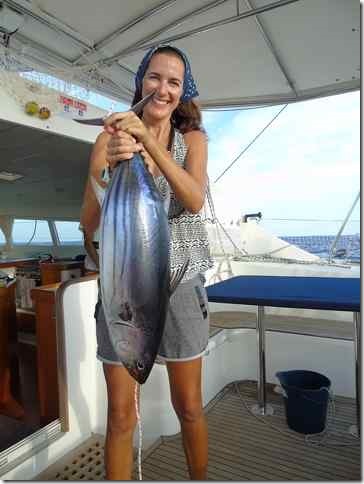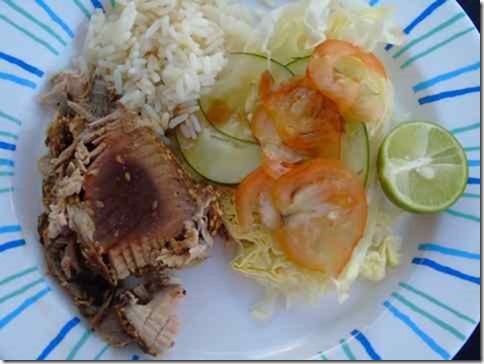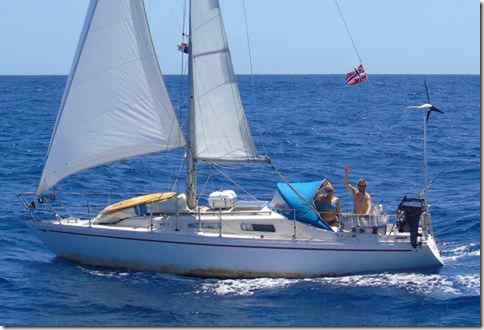Fish at last

Lovesail
Thu 26 Mar 2015 05:17
|
08:08S 119:10W
25 March 2015
Things are looking up. First, we are enjoying steady breeze from the
ESE which is just enough to allow us to maintain our westerly course. But
you’re bored of winds, so let’s talk fish. Yes, at last we broke our
duck. Lucy put out the lure at 0530 in the morning and 10 minutes later,
ziiiiiiiiiinnnnngggg. That got everyone out of bed in a hurry and after an
epic fight with a giant of the deep, Lucy landed a fine tuna, variously
estimated at up to 20 kg. If the scales don’t agree, that’s not my
fault. Anyway, it’s quite a whopper and enough to satisfy our cravings for
fresh fish for a while. There she is with her prize:
 The team then clicked into action. Lucy filleted the fish, Elizabeth
then trimmed and cut into portions. Using our amazing vac-pac machine we
can pack the fish and keep it for up to three weeks in the fridge. There
was enough meat for 40 meal portions! So either we’ll be eating a lot of tuna,
or else trading with the islanders for pork and vegetables.
 After sashimi for lunch Lucy prepared the most wonderful seared tuna for
dinner. Yum, delicious.
 Another bit of fun: we’ve been sailing in company with a young Norwegian
couple in their 31 ft boat. They’re not part of the rally but have found
themselves amongst us. We chat on the radio from time to time if they are
in range. So yesterday they we pretty close to us so we dropped our
spinnaker in order to slow down and let them catch up, then we manoeuvred close
to them so that we could see them and actually talk across the water:
 They are called Lise and Jens, and they are on their way to
Australia. That’s a surf board on the foredeck so maybe they’ll hook up in
Bondi later in the year. And that’s either a very large outboard on the
back or a very small yacht (yes, it is small).
It’s strange to be out here in this huge blue ocean and then come across
another boat. - any boat. We’ve seen a couple of ships and some
fishing boats since leaving the Galapagos. One, japanese, came quite close
so we called them on the radio. I gave them the old konichi-wa which they
thought was very funny “Ha, ha, ha! Konichi-wa!. No speak
English” Click! Other yachts in our fleet have reported these same
japanese fishing together at night. Unfortunately most of them do not show
up on AIS and neither to they respond to VHF call on Channel 16, making it
difficult to choose a correct course to avoid them.
AIS is a brilliant invention that has recently become available to leisure
sailors. Basically all commercial vessels are supposed to broadcast an AIS
signal which identifies the vessel and which also gives position, course and
speed data. This signal can then be picked up and displayed on our chart
plotters. A bit like radar you might think. Yes it is, but much more
reliable since the data actually comes from the vessel itself and doesn’t have
to be imputed from a very imperfect image on a radar screen. It’s also
very energy efficient, since the data comes over the same VHF radio spectrum
used for voice comms. Radar, on the other hand, draws a lot of power from
our poor old batteries so we don’t/can’t keep it on all the time
Like radar, but better, one can also set up alarms on the chart plotter that go
off if an AIS target comes within, say, 8 miles. In theory, the watch
keeper can just wait for an alarm to go off before going to take a look at
what’s going on. However if a ship is not broadcasting on AIS, like those
pesky fishermen, then that won’t work. Tut, tut. Of course, we do always
keep a look out, whatever is going on. I tell myself, just suppose it was
me out there in a life raft waving and letting off flares while this stupid
catamaran sailed past without noticing. That’s enough to jolt me into
picking up the binoculars and having a good hard look around. “Keep a
sharp lookout” as the French coast guard used to say on the radio in
Martinique.
Only another 1,200 miles to go before we’ll be speaking French again.
It seems like we are almost there, but in truth it’s still a long way.
M |